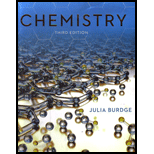
Interpretation:
The Lewis structure of OH radical is to be drawn.
Concept introduction:
Lewis structures of molecules are drawn by considering the valence electrons present in each atom of the element.
Lewis structure of a molecule represents the type of bonds between the elements of the molecule.
In Lewis dot
In Lewis dot symbol, valence electrons are represented by dots.
Dots are placed above and below as well as to the left and right of symbol.
Number of dots is important in Lewis dot symbol but not the order in which the dots are placed around the symbol.
In writing symbol pairing is not done until absolutely necessary.
For metals, the number of dots represents the number of electrons that are lost when the atom forms a cation.
For second period nonmetals, the number of unpaired dots is the number of bonds the atom can form.
Atomic ions can also be represented by dot symbols, by simply adding (for anions) and subtracting (for cations) the appropriate number of dots from Lewis dot symbol.
Want to see the full answer?
Check out a sample textbook solution
Chapter 8 Solutions
Chemistry
- Question 1: CuCl2 is a stable compound, whereas neither CaCl nor CaCL3 are known as unstable compounds. Account for this observation. a)i) Distinguish between the expression (bond energy term and Bond dissociation ) Under what circumstances would these necessarily have the same value?arrow_forwardPractice Exercise 1Although it is helpful to know that many ions have the electronarrangement of a noble gas, many elements, especially among themetals, form ions that do not have a noble-gas electron arrangement.Use the periodic table, Figure 2.14, to determine which ofthe following ions has a noble-gas electron arrangement, andwhich do not. For those that do, indicate the noble-gas arrangementthey match: (a) Ti4+, (b) Mn2+, (c) Pb2+, (d) Te2- , (e) Zn2+.arrow_forward(please show reaekson and incorrect option explain and correct answer) In the major resonance structure for CN^-, what is the formal charge on the N atom? A) 0 B) +2 Q-1 D) +1arrow_forward
- QUESTION 2 Use the table below to determine ΔH for the following reaction H 2C=CH 2(g) + F 2(g) ↔ CH 2FCH 2F(g) Bond Energies, kJ/mol Single Bonds H C N O S F Cl Br I H 432 C 411 346 N 386 305 167 O 459 358 201 142 S 363 272 --- --- 286 F 565 485 283 190 284 155 Cl 428 327 313 218 255 249 240 Br 362 285 243 201 217 249 216 190 I 295 213 --- 201 --- 278 208 175 149 Multiple Bonds C=C 602 C=N 615 C=O 799 C≡C 835 C≡N 887 C≡O 1072 N=N 418 N=O 607 S=O (in SO2) 532 N≡N 942 O2 494 S=O (in SO3) 469 Key Concept: ΔH° rxn = ∑ΔH ° bonds broken - ∑ΔH ° bonds formedarrow_forwardSome plant fertilizer compounds are HNO3, H2SO4, H3PO4, NH4NO3, and K2CO3. Which of these compounds contain both ionic and covalent bonds? (Select all that apply.)arrow_forwardWhich of the following atoms do NOT have 5 valence electrons? Select all that applyarrow_forward
- explain difference between non-polar and polar covalent compound along with example of this type of bond in clear handwritten answer!arrow_forwardICl5 draw all possible lewis structure show processarrow_forwardSelect all that apply.Consider the following molecular shapes.h5sil1031(a) Which has the most electron pairs (both shared and unshared) around the central atom?ABCD(b) Which has the most unshared pairs around the central atom?ABCD(c) Do any have only shared pairs around the central atom?ABCDNonearrow_forward
 General Chemistry - Standalone book (MindTap Cour...ChemistryISBN:9781305580343Author:Steven D. Gammon, Ebbing, Darrell Ebbing, Steven D., Darrell; Gammon, Darrell Ebbing; Steven D. Gammon, Darrell D.; Gammon, Ebbing; Steven D. Gammon; DarrellPublisher:Cengage Learning
General Chemistry - Standalone book (MindTap Cour...ChemistryISBN:9781305580343Author:Steven D. Gammon, Ebbing, Darrell Ebbing, Steven D., Darrell; Gammon, Darrell Ebbing; Steven D. Gammon, Darrell D.; Gammon, Ebbing; Steven D. Gammon; DarrellPublisher:Cengage Learning
 Introduction to General, Organic and BiochemistryChemistryISBN:9781285869759Author:Frederick A. Bettelheim, William H. Brown, Mary K. Campbell, Shawn O. Farrell, Omar TorresPublisher:Cengage Learning
Introduction to General, Organic and BiochemistryChemistryISBN:9781285869759Author:Frederick A. Bettelheim, William H. Brown, Mary K. Campbell, Shawn O. Farrell, Omar TorresPublisher:Cengage Learning Chemistry In FocusChemistryISBN:9781305084476Author:Tro, Nivaldo J., Neu, Don.Publisher:Cengage Learning
Chemistry In FocusChemistryISBN:9781305084476Author:Tro, Nivaldo J., Neu, Don.Publisher:Cengage Learning



